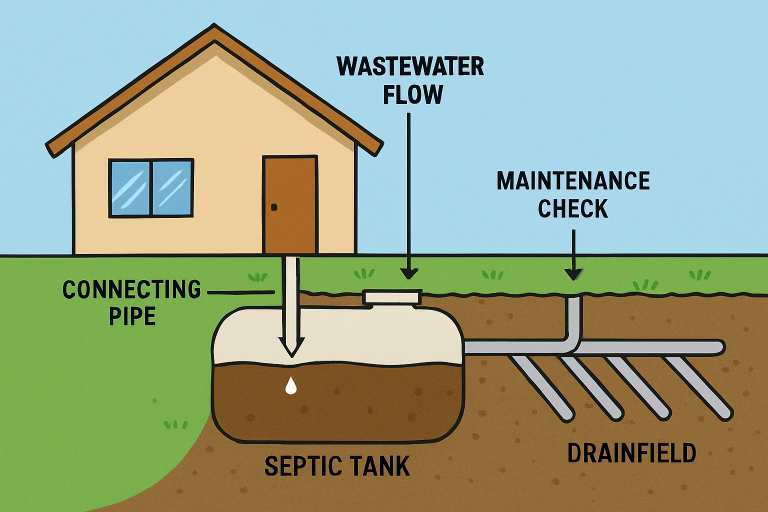How to Keep Your Septic System Flowing for Years to Come
Table of Contents
- Introduction
- Regular Inspections and Pumping
- Water Conservation
- Proper Waste Disposal
- Drain Field Maintenance
- Use of Septic-Safe Products
- Landscaping Considerations
- Educating Household Members
- Recognizing Warning Signs
Introduction
For homeowners who rely on a septic system, routine care is a must to avoid costly issues and maintain a safe, healthy environment. Small actions taken today can save you from major headaches tomorrow. One key aspect of this maintenance involves regular septic pumping, which keeps your system running smoothly and helps prevent unexpected breakdowns.
Septic systems play a vital role in managing household wastewater, and investing time in maintenance can protect your property and the environment. This guide provides actionable steps and expertise rooted in professional and government recommendations, so you can keep your septic system performing efficiently year after year.
Neglecting septic care can lead to significant repair costs and even health risks for your family. Fortunately, homeowners can confidently manage their systems with a proactive approach and enjoy peace of mind. Sticking to these tips ensures you get the most from your investment in your home’s wastewater management solution.
A comprehensive maintenance routine includes regular pumping and professional septic services—from inspections to repairs—to ensure every component of your system is functioning as it should. Here are the detailed strategies every household should follow for long-term septic health.
Regular Inspections and Pumping
The cornerstone of effective septic maintenance is having your system professionally inspected every three years and pumped out every three to five years—based on water usage and household size. The U.S. Environmental Protection Agency (EPA) emphasizes that regular inspections help identify early warning signs of trouble, such as sludge buildup or water pooling, and routine pumping removes accumulated solids that could otherwise cause costly backups or overflows. For further reading, the EPA’s guide offers a detailed breakdown of how and when to schedule service.

Water Conservation
Reducing the volume of water entering your septic system protects it from becoming overwhelmed and extends its lifespan. Fix leaky faucets and toilets as soon as you notice them, spread out loads of laundry across the week, and upgrade to water-saving fixtures such as low-flow toilets and showerheads. Practicing these daily habits can help prevent system overload while lowering your water bill. Retrofitting homes for efficiency often yields significant savings and long-term benefits, supported by advice from large-scale publications like EPA’s WaterSense program.
Proper Waste Disposal
Only flush human waste and toilet paper to avoid introducing harmful materials into your septic system. Keep products like diapers, wipes (even “flushable” ones), dental floss, and feminine hygiene items away from your toilets. Never pour grease, fats, or oils down the drain in the kitchen, as they can solidify and clog your pipes or the tank. Instead, dispose of them in the trash. Keeping inappropriate items out of your septic system protects the delicate bacterial environment that helps break down waste. For more information, refer to the EPA’s guidelines.
Drain Field Maintenance
Preserving Effective Wastewater Treatment
The drain field is critical to the filtration and absorption of wastewater. Never park or drive vehicles over the drain field to keep this area working efficiently, as compacted soil cannot absorb water effectively. Be mindful of where trees and shrubs are planted—roots can invade and damage pipes, causing leaks and system failures. Ensure gutters, French drains, or sump pumps direct water away from the drain field, preventing oversaturation that might result in untreated sewage resurfacing above ground. More details can be found in the EPA’s recommendations.
Use of Septic-Safe Products
Protecting the ecosystem inside your septic tank is essential for effective waste breakdown. Choose cleaning agents and detergents labeled “septic safe,” typically biodegradable and low in phosphate content. Harsh chemical cleaners or drain openers can kill the beneficial bacteria your system relies on. If you need to address a clog, opt for mechanical solutions like plungers or a drain snake (never chemicals). For comprehensive lists and information, consult The Spruce’s review of septic-safe cleaners.
Landscaping Considerations
Thoughtful landscaping protects your septic system and enhances your property’s appearance. Grassy cover works best over drain fields because it controls erosion and absorbs excess moisture. Avoid deep-rooted plants and trees near any septic component, as invasive roots cause costly repairs. If you need to make changes around your septic system, always consult with a septic professional or landscaper familiar with local codes and best practices to ensure your plans won’t cause issues down the line.
Educating Household Members
All household residents should understand what can and can’t be flushed down toilets or poured into drains. Take time to explain the basics of septic care, such as using only approved products and reporting persistent drain issues as soon as they’re noticed. Providing this knowledge goes a long way toward preventing mistakes and keeps everyone involved in maintaining the system’s longevity.
Recognizing Warning Signs
Early detection of septic problems means easier and more affordable solutions. Be alert for persistent slow drains, foul odors inside or outside the home, gurgling sounds in the plumbing, or standing water over your drain field. If you notice any of these signs, contact a septic service professional immediately to prevent minor issues from growing into major repairs.
Adopting these practical, proven tips and enlisting expert help when needed will keep your septic system running effectively for years. This commitment protects your investment and guards your family’s health and the local environment.




